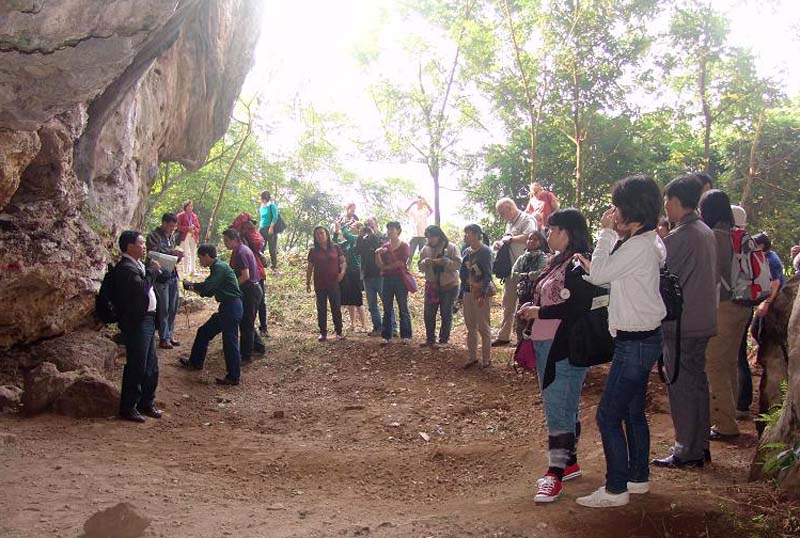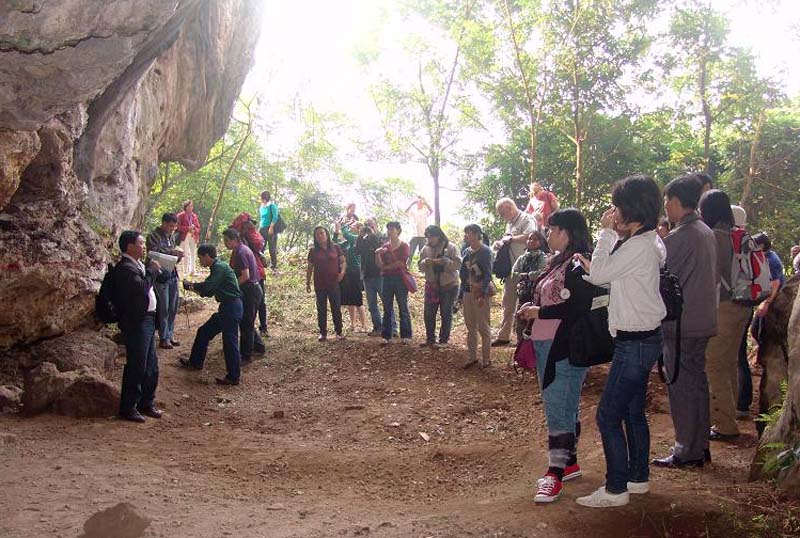
(HBO) - Hoa Binh city Currently there is a road and a hotel named Colani in Hoa Binh City. It is a tribute to the French archaeologist, Madelene Colani, who has proposed the concept of "Hoa Binh Culture” and it is also for the other generations of Hoa Binh people to know and be proud of the place where they are living, which is the cradle of "Hoa Binh Culture”.
Hoa Binh culture is a famous culture of the prehistoric period, which was 18,000 years ago. This is a typical culture in the mainland Southeast Asian countries, in southern China and in the western part of the delta of the 3 big rivers in Northern Vietnam, in which there is Da River running through the territory of Hoa Binh province.
From the excavation of relic sites of the caves in the limestone mountainous area of Hoa Binh, in 1927, the French archaeologist, Madelene Colani, proposed the concept of "Hoa Binh Culture”. Accordingly, in 1932, the first conference of Far Eastern prehistoricists meeting in Hanoi recognized the term "Hoa Binh Culture” as a term to refer to an ancient culture that appeared and existed on territory of prehistoric Vietnam, and affirmed that Hoa Binh was one of the centers of the primitive people in Vietnam.
According to the research by M.Colani: the residents of "Hoa Binh Culture” used to live in groups in caves, hunting and collecting food for a living. The people at that time knew how to use pebbles with their crafting to create almond-shaped, disk-shaped and later short ax-shaped tools.
Ms. Nguyen Thi Thi, the Director of the Provincial Museum, who has studied and unearthed the archaeological relics related to the "Hoa Binh culture” for hundreds of times says: Currently, over 130 sites under Hoa Binh culture” have been discovered in Vietnam, of which, there are over 70 relics discovered and studied in Hoa Binh. The archaeological sites belonging to "Hoa Binh culture” are mainly located in the caves and on the stone roofs.
They have been discovered in Can cave, in the cave of Trai hamlet, on the stone roof of Vong hamlet, on the stone roof of Tom, on the stone roof of Chieng Khen, in the cave of Doi hamlet, in Muoi cave and so on. These common relics in "Hoa Binh culture” is the kitchen, the burial tombs, the post-meal ruins, the labor tools and the other artifacts of the primitive people. The traces of the clam shells, snails, the animal teeth and bones, and the nut shells of some herbs have been remained in the cultural layer and a large number of relics, animal and human bones.
Currently, a number of relics are stored in the Provincial Museum. They are on the display on the occasion of the province's major holidays and they have been participating in thematic exhibits at the regional level with a view to introducing the visual images showing the steps of human evolution through "Hoa Binh Culture”. The displays on "Hoa Binh Culture” are often the simulations and reconstruction of a cave of the accommodation of the primitive people. There are the people, the fire stoves, the stone working tools, and there are a lot of shells, stone tools and pieces of scrap (eaten and left by humans) on the floor of the cave.
Proudly living in the cradle of "Hoa Binh culture”, Hoa Binh people always raise the awareness of preserving and promoting the cultural identity, creating their own characteristics of the gateway land of the Capital and the gates in the Northwest of the country.
The researchers and the students are visiting the relics of Trai cave, Tan Lap commune (Lac Son) - an excavation of the related to "Hoa Binh culture”
The People’s Committee of Lac Son district held a ceremony on April 28 to receive the provincial relic certificate for the ancient rock carving site at Suoi Co stream, located in My Thanh commune.
A special music show titled "The country is in the fullness of joy” has been held at Hoa Binh Square in Hoa Binh city in celebration of the 50th anniversary of the liberation of the South and national reunification (April 30, 1975–2025).
The People's Committee of Lo Son commune, Tan Lac district, has organised the local annual traditional stream fishing festival on April 19 - 20.
As a land deeply intertwined with human history and Vietnam’s millennia-long journey of nation-building and defence, Hoa Binh is often revered for its epic tales and legends.
Residents of Hoa Binh boast a rich cultural identity, reflected in their unique language, traditional attire, customs, and folk melodies – described as "sweet as honey, clear as a mountain stream.”
Lac Son district’s Vu ban town held the 2025 Truong Kha temple festival on April 12–13 (the 15th–16th days of the third lunar month). Since its revival in 2019, the festival has been organised every three years, preserving valuable intangible heritage while meeting the community’s cultural and spiritual needs.



